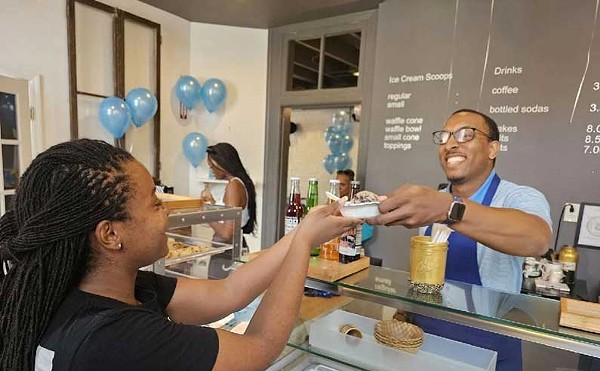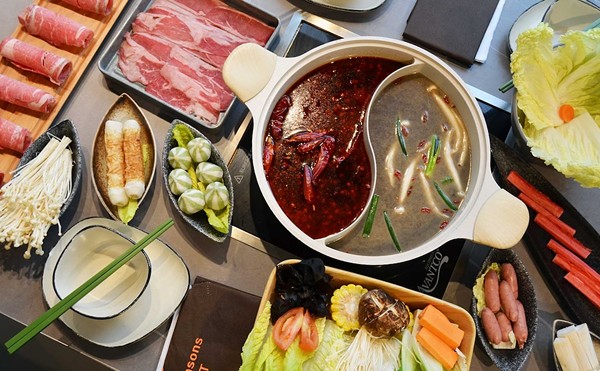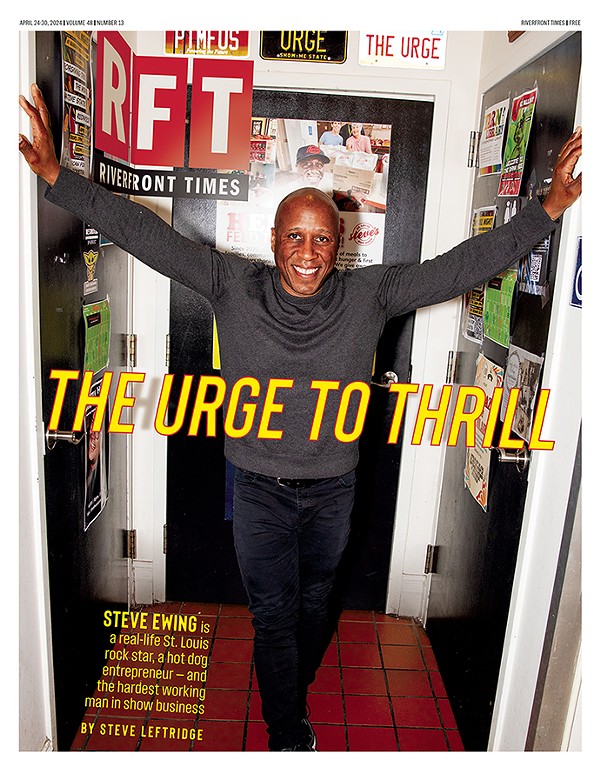The sushi lounge is a concept fast on its way to reaching full-out trend, both nationwide and here in St. Louis. Rue 13, the only bona-fide lounge on downtown's Washington Avenue club strip, reaped great rewards when the sushi bar it's got tucked away in a corner became a selling point among patrons. In the right fizzy-sleek setting, there's something undeniably chic and hip, flirty even, about sensuous slices of raw fish, chopsticks and the fierce kick of wasabi. Drunken Fish sure is more fun for the kids (myself included) than the Seki/Sansui/I Love Mr. Sushi establishments, which tend to be overlorded by humorless Japanese matrons and male sushi chefs of few words. For cosmopolitan gals and metrosexual men, sushi (also tapas, I'd say) has become a finger food of choice, so the demographic calls for a place like Drunken Fish to capitalize on that. Whether it also calls for a DJ booth may prove to be just one of many factors that determine Drunken Fish's long-term success.
Another sushi conundrum (who knew there were so many?) is this: California roll six-packs sell alongside the seafood counter at Schnucks. Where's the sexy in a food you can chuck into your shopping cart with your cottage cheese? Sushi is going haute cuisine and workingman's lunch simultaneously -- and unless it finds a fabulous fourth dimension, the high end might lose out to the low end. Drunken Fish's menu attempts a way out of that quandary, as chef Tome Viduka -- a native Croatian, which, like most everything else about Drunken Fish, is cool yet odd -- goes ballistic on his ingredients, creating (just as a first example) three house-original maki rolls best described as hypersushi.
The So roll: crabmeat, fish of the day (usually tuna), radish sprouts, scallions and carrots wrapped in seaweed (no rice), tempura-fried, served in a martini glass. The Tyoka roll: eel and crab rolled in rice, blanketed by an external layer of avocado slices, smothered with warm baked crab and scallop pieces, topped with a little masago (that teensy orange roe) and "Japanese mayonnaise." The Drunken Fish roll: tempura shrimp and steamed asparagus smeared with Japanese mayonnaise, rolled in rice and seaweed, topped with masago, raw tuna, more Japanese mayonnaise, eel sauce and radish sprouts, sprinkled generously with tempura crunchies.
These are all towering, daunting pieces of architecture, presented artfully (sometimes with spindly, fan-shaped plumes of fried noodles) on stylishly understated plates. In fact, the dishware scheme's very Queer Eye for the Straight Guy, and it's my favorite thing about the restaurant. Still, they don't always taste as imaginative as they look. I did love the Tyoka roll, thanks to the scallops, which were so yummy I'd eat them solo. (And I can; small fistfuls jacketed in seaweed are available as an unorthodox form of nigiri.) On the other hand, the tempura coat that covers the Drunken Fish roll does it a disservice, nullifying the distinct flavors of its many components. A great array of textures happens here -- the snap of the asparagus, the crunch of the roe, the goo of the mayonnaise, the tempura itself -- but they meld into a uniform, bland whole.
Tempura is a motif on this menu, and again, it pays off sometimes but not all the time. The most audacious tempura creation is the fried lobster, a platter of batter-encrusted tail meat adorned with slices of different kinds of tempura vegetables: squash, mushrooms, sweet potato, etc. Fried lobster sounds like two great tastes that would taste great together, but once more, the tempura annuls the flavors that should follow. The lobster's essence is barely detectable; even more of a shame, the meat loses its incomparable velvet feel.
But the accompanying tempura vegetables rock! With them, the frying reaps tremendous dividends, fresh flavors bursting and leaping about the mouth. Here again is something I would and did order on its own, via the tempura appetizer. While submitting maki rolls and lobster tails to a tempura treatment smacks of trying too hard, the tempura vegetables conversely register as less-is-more cooking. And when that approach is used, Drunken Fish's food excels. Edamame, a tuna tataki appetizer and a steak teriyaki entrée (each of the latter two presented simply as roast beef-like slices), straightforward seaweed salad and octopus salad -- all perfect.
So are the desserts, which surprised me. There's just a trio of ice cream concoctions, but two -- the deep-fried ice cream and the mochi ice cream -- are more gussied up than what you usually get at a Japanese restaurant. (Abrupt turn: Suddenly more is more!) For the deep-fried ice cream, a scoop of green tea is tempura-fried just right, then served quartered alongside lovely whipped cream dollops, fresh fruit slices and chocolate sauce doodles. The mochi takes mango, strawberry or coffee ice cream and encases it in a rice-based dough (that's the mochi) that feels remarkably like a soft, pulpy outer skin.
For all the complexities and curiosities that make up Drunken Fish's menu -- and it is quite big, encompassing long lists of nigiri and sashimi, more than I can possibly mention here -- it seems secondary to the lounge side of the Drunken Fish equation. The space looks exactly as I pictured it: pink-hued mood lighting, couches upholstered in muted tones, low tables and a long bar up front. The drink menu's even bigger than the food menu -- sake, martinis, sake martinis, Japanese and domestic beers, soju (a Korean spirit clocking in with a 22 percent alcohol content), a weak wine list dominated by Mondavi and Kendall-Jackson, frothy cocktails -- and I do not think it happenstance that just the drink menu sits on tabletops awaiting customers. In fact, edibles don't even get a proper bill of fare, merely the standard sushi ordering form, where choices are listed solely by name (no descriptions) and you jot down the quantities of which items you want. The bar turns out confidently poured libations, while the table service could stand to be more knowledgeable, especially seeing as how questions must be asked in order to fill in all the blanks that the lack of a menu leaves behind. That "Japanese mayonnaise"? I was told it's "like a sour cream thing."
Another significant way Drunken Fish leans more toward lounge: It's expensive! Cocktails run in the $7 range, beers from $4 to $8 (though the latter buys you one of those jumbo Sapporo cans). And those house sushi rolls cost up to $15.75.
Which brings us to the DJ booth. Club-style spinning takes place on weekend nights; otherwise a laptop plays similar techno beats but at a much lower volume. Considering there's no dance floor, the DJ cranks it way too loud -- a metaphorical crying-out of Drunken Fish's identity crisis. Is this a restaurant or a lounge? I don't think that has been entirely figured out.
Sushi's running rampant across the local restaurant scene, yet we still haven't reached the saturation point. For that reason, The Drunken Fish is a welcome addition that brings new avenues to the table. But it feels like the lure here comes not from genuinely wanting to push the gastronomic envelope but rather from employing sushi shock tactics. I ate the fish, but I can't say I entirely took the bait.





